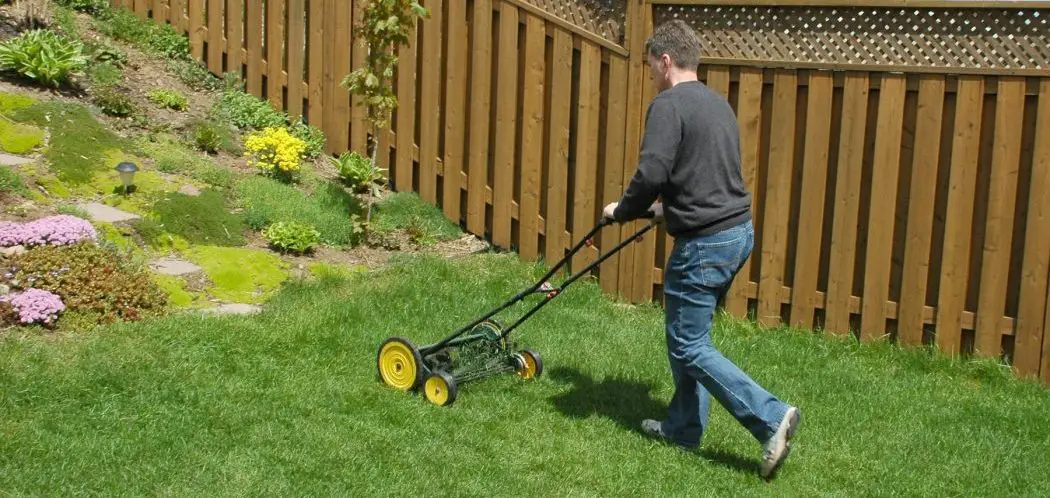If you’re considering a reel mower purchase, one vital question that arises is just how heavy are they compared to the traditional gas-powered rotary mowers you might be used to? Weight significantly impacts ease of use, maneuverability, and even cutting performance.
In this in-depth guide, we’ll closely examine:
- The typical weight ranges among different reel mower categories
- How specifications like width, materials, and power source affect heft
- Weight variances between manual, powered, and golf reel models
- The pros and cons of both heavier and lighter reel mowers
- Features that add or reduce pounds on certain mower models
- How to select the optimal reel mower weight for your property and needs
- Real-world examples of reel mower weights
Understanding precisely what to expect in terms of reel mower mass and key weight considerations helps ensure you choose the properly equipped machine for your lawn and physical abilities. Let’s really drill into the numbers and weight impacts!
Manual reel mowers typically weigh 25-45 lbs. Powered models range from 75-200+ lbs. Heavy 400 lb+ commercial greens mowers are for golf courses.
Overview of Typical Reel Mower Weight Ranges
So just how substantial are reel mowers compared to the gas-powered rotary mowers most homeowners are accustomed to using regularly? Here’s an at-a-glance look at the typical weight ranges:
Manual Push Reel Mowers – 25 to 45 pounds
Powered & Self-Propelled Reel Mowers – 75 to 200+ pounds
Professional Golf and Sports Turf Reel Mowers – 200 to 400+ pounds
As you can see, non-motorized manual reel mowers occupy the featherweight spectrum, and represent a drastic reduction from those heavy 150+ pound gas mowers.
But powered reel models quickly add bulk that puts them much closer to conventional rotary weights. And large-scale commercial green mowers understandably top the scales for reel types.
Understanding where these broad categories fall in terms of pounds gives helpful context before diving into the specifics of what accounts for weight differences between models.
First, let’s zoom in on manual push reels.
Light and Lean – Manual Reel Mower Weights
Starting on the lithe end of the reel weight spectrum, non-powered push reel mowers tip the scales between roughly 25 to 45 pounds in most cases. Their simplicity accounts for minimal mass:
Typical Range: 25-45 lbs
Lighter Models: Under 30 lbs
Heavier Models: Approaching 50 lbs
These manually operated mowers save weight thanks to straightforward construction with fewer moving parts compared to powered equipment.
Many homeowners opt for lightweight manual reel mowers specifically because they’re exponentially easier to maneuver around landscaping, lift over obstacles, store in a garage or shed, and handle during use than heavy gas mowers exceeding 150+ pounds.
However, extremely featherweight models can pay the price in terms of cutting performance and traction thanks to their plastic components and stamped steel construction. Heavier manual reels around 40-45 lbs offer a nice balanced weight.
Now let’s look at motorized walk-behind reel weights.
Motorized Reel Mower Weights Span a Wide Range
Once engine components like gas motors or electric start motors enter the equation, reel mower weight increases substantially and varies even more:
Typical Range: 75-200+ lbs
Lighter Models: 75-100 lbs
Heavier Models: 175-200+ lbs
Their onboard power systems allow these walk-behind motorized reel mowers to take on tougher turf and provide stability – but at the cost of added pounds from metal engines and beefed up drive components.
Many powered reel mowers occupy the 100-150 pound range, which some users find cumbersome to repeatedly turn and maneuver on intricate lawns. But extremely light 75 lb models border on flimsy, flexing excessively.
The real heavyweight greens mowers deserve special attention…
Professional Golf and Turf Reel Mowers Carry Considerable Heft
Once you get into the commercial riding reel mowers built for perfectly manicured golf courses and athletic fields, the weight soars to support relentless daily use:
Typical Range: 200-400+ lbs
Lighter Models: Around 200 lbs
Heavier Models: Over 400+ lbs
These precision cutting machines utilize robust steel or aluminum frames, dual wheels, and leverage to provide unparalleled quality of cut and customization for grass down to 1/8 inch.
But the extreme weight renders them unrealistic for typical homeowners mowing 1-2 acres of residential lawn. Plus issues like garage storage space for a 400 lb mower!
Now that you understand where the main reel mower categories fall regarding weight, what accounts for why certain models end up markedly lighter or heavier?
Key Specs That Influence Reel Mower Weight
While all reel mowers fall into relatively defined weight ranges, several engineering factors lead individual mower models to land at the lighter or heavier end of the spectrum:
Cutting Width
The deck width has major implications for overall weight. Wider cutting swaths necessitate more robust frames, heavy-duty wheels, and fortified components to maintain chassis stability without flexing.
As an example – a 14-inch cutting width manual reel may clock in at a featherlight 25 pounds. But jump up to a 20-inch cutting deck and the weight could rapidly scale up closer to 40+ pounds.
Similarly, a powerful 25-inch wide commercial reel will be substantially lighter than a 60-inch beast. Deck proportions translate directly to mower heft.
Construction Materials
The metals and manufacturing methods used in a reel mower significantly determine the pounds on the scale. Thinner stainless steel housing and plastic components reduce weight. But cast iron frames, thick-gauge steel, and aluminum or magnesium alloy parts add bulk.
Overall chassis construction quality also factors in. Lower grade light materials may dent and fail faster depending on thickness and reinforcements. Analyze materials closely rather than assuming light metals equal flimsiness.
Power Unit Type
Gasoline engines represent a massive hunk of added weight compared to electric or manual reel models. Large single cylinder or twin cylinder gas powerplants can account for over half the total mass in motorized reel mowers.
Even amongst gas motors, heavier cast iron legacy engines equate to greater pounds versus updated lightweight alloy engine blocks in modern mowers.
Electric mowers ditch gas powerplant anchor weight, but must still account for heavy batteries and on-board chargers. Any power source adds weight over manual push units.
Wheel Size and Design
Larger diameter alloy or air-filled pneumatic wheels and tires add weight but also boost stability and terrain handling. Some reel models employ lightweight plastic composite wheels to subtract valuable pounds.
So when examining reel mower specs, recognize width, materials, power, and wheels all play crucial roles in whether models tip lighter or heavier. Let’s compare how weights differ across reel categories.
Notable Weight Differences Between Reel Mower Types
We’ve established rough weight ranges for the 3 main reel mower breeds earlier. Now let’s dive deeper into how the weights and limiting factors differ:
Manual Reel Push Mowers
Their lack of motors and simplified construction concentrates these mowers on the low end of weight scales. Reduced mass aids storage, lifting, and maneuverability but hampers traction.
Narrow 14-16 inch lightweight models around 25 pounds float over lawns with ease, but may lack necessary mass to power through thick turf or grip well on hills. Heavier 40-50 lb models gain enhanced cutting power and traction while remaining reasonably portable.
When evaluating manual reel mowers, look for optimal balance between adequate traction capability and easy handling based on your terrain and strength.
Powered Walk-Behind Reel Mowers
Onboard gas or electric motors allow self-propelled units to take on tougher turf and provide essential stability, but at the cost of extra load from metal powerplants.
Many fall in the 100-150 lb range, which some users find cumbersome to repeatedly turn on convoluted lawns. Extremely light 75 lb models risk chassis flexing in use and sound flimsy. Look for sturdy but manageable middle weights around 125 lbs for solid performance without overburdening the operator.
Professional Golf and Sports Turf Reel Mowers
These heavy-duty machines utilize steel or aluminum frames plus twin wheels to support unrivaled daily mowing precision across acres of grass.
But the 300-400+ lb weights make them unrealistic for homeowners mowing typical 1-2 acre residential lots. Plus good luck fitting them through gates and shed doors!
While vital for perfectionist golf course superintendents, stick with regular walk-behinds for suburban lawns unless you have storage space and transport ability.
Now that you understand how weight differs across the board, let’s break down the unique pros and cons of heavier vs. lighter options.
Pros and Cons of Heavyweight Reel Mowers
Here are the main benefits heavier reel mowers deliver along with some potential disadvantages:
Pros of Added Weight
- Improved traction and grip, especially in damp grass
- Ability to power through dense or thick turf
- More stable and resistant to sliding on slopes
- Sturdy and robust build quality and components
- Smooth, fluid driving motion and momentum
Cons of Heavy Weight
- Much harder for some users to pivot and maneuver
- Challenging to lift or load into vehicles for transport
- Difficult to hand lift for vertical storage or hanging
- Increased momentum risks lawn divots and injury if uncontrolled
Finding the point where a mower is heavy enough for performance yet light enough for practical handling is the tightrope walk engineers must perfect.
Pros and Cons of Lightweight Reel Mowers
Alternatively, here are the main upsides and potential pitfalls that come with lightweight reel mowers:
Pros of Light Weight
- Extremely easy to turn and maneuver even in tight spaces
- Can be carried or lifted over obstacles with minimal effort
- Simplifies storage by easily mounting to garage walls
- Less physically taxing for extended mowing sessions
- Reduced risks if the mower is accidentally dropped
Cons of Light Weight
- Prone to sliding uncontrollably down steep slopes
- May lack grip powering through thick soggy grass
- Easily knocked off mowing path by minor terrain variations
- Not enough mass for momentum through dense turf
- Cheap lightweight materials may buckle or snap
The ideal weight offers easy maneuverability without sacrificing too much power and stability. Let’s look at features that influence where models fall on the scale.
Features That Add or Reduce Reel Mower Pounds
Certain design elements push specific reel mower models heavier or lighter relative to competitors:
Weight-Adding Features and Materials
- All-steel construction including cast components
- Wide cutting decks over 20 inches
- Large diameter drive wheels
- Heavy onboard gasoline engines
- Protective steel side panels or full enclosures
- Expanded rear grass catcher bags
Weight-Reducing Features and Materials
- Aluminum, plastic, or thin-gauge steel components
- Narrow 14-18 inch cutting widths
- Composite wheels with aluminum hubs
- No power unit on manual mowers
- No outer side panels or guards
- Small mesh grass collection bags
Seeking out made with lightweight yet durable materials can pare valuable pounds off a mower’s frame without sacrificing resilience. But avoid flimsy construction.
How to Choose the Optimal Reel Mower Weight
Given all these insights into typical weights and factors at play, how should you choose the properly proportioned reel mower for your needs?
Consider key questions like:
- Will you need to load the mower into vehicles frequently for transport? If so, keep weight very low.
- Do you need to carry the mower up steps or over obstacles such as curbs? Prioritize lightness.
- Do you lack upper body strength due to age or health conditions? Stick with under 30-35 pound models.
- Is your property hilly or sloped? Heavier reels strongly resist sliding and slippage.
- Is your grass extremely dense and thick or moist frequently? Added mass powers through easily.
- Will other family members need to operate it? Ensure it’s not overly heavy for lighter individuals.
- Does your lawn have intricate landscaping borders and patterns? Super lightweight models excel making tight turns.
Let your realistic property terrain and physical capabilities guide you to the optimal reel mower weight rather than assumptions about required heft. Test models firsthand at dealers.
Examples of Reel Mower Weights
To give you a better idea of actual weights for different models, here are 20 examples across manual, powered, and golf reel mower varieties:
Manual Reel Mowers
- American Lawn Mower Deluxe – 25 lbs
- Fiskars Staysharp Max – 52 lbs
- Gardena 4025-U – 31 lbs
- Great States 204-5 – 35 lbs
- Greenworks Cordless – 43 lbs
- Scott’s Manual Greens – 34 lbs
- American Lawn Mower Classic – 39 lbs
Powered Reel Mowers
- Craftsman 20” Powered – 114 lbs
- Earthwise 50214 – 56 lbs
- Husqvarna 5521P – 105 lbs
- Ryobi 20” Electric – 75 lbs
- Scotts 2000-20S – 83 lbs
- Sun Joe MJ401E – 43 lbs
- Greenworks 25102 – 71 lbs
Golf and Commercial Reel Mowers
- John Deere 220E – 400 lbs
- Toro Flex 2100 – 215 lbs
- Toro Greensmaster 1000 – 240 lbs
- Jacobsen GKIV – 290 lbs
- John Deere 260SL – 475 lbs
- Toro Greensmaster Flex 1800 – 255 lbs
- Jake’s Pro Lawn – 380 lbs
This sampling gives you a real-world look at the range of weights available. Generally lighter for push, moderate for self-propelled, and heavy for pro turf models.
Key Takeaways on Reel Mower Weights and Impacts
When evaluating different reel mower models, keep these weight considerations in mind:
- Manual push reels are the lightest at 25-45 pounds typically. Powered units run heavier.
- Cutting width, materials, engines, and wheels determine overall heft.
- Added weight improves traction and robustness but limits maneuverability.
- Extremely light reel mowers sacrifice key stability and cut power. Seek balance.
- Carefully match weight to your terrain, grass density, storage ability and physical strengths.
Still have any other questions about reel mower weights? Ask them below so we can provide more helpful details! Being informed on approximate weights makes shopping and using reel mowers simpler.
Find Your Perfect Reel Mower Weight
If you’re accustomed to the substantial feel of gas-powered rotary mowers, reel mower weights may initially seem either too light or too unwieldy.
But spend time testing different reel weights firsthand. Their more manageable lightness often becomes a huge perk for easing fatigue and improving control.
Just be sure to select a weight realistically tailored to your property’s unique terrain and your lifting/handling abilities. With so many models available today, you can certainly find a reel mower with ideal balanced weight.
Now that you’re informed on the pounds, share your own reel mower recommendations or experiences with different weights in the comments below to help other readers select the optimal heft.





